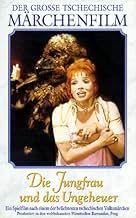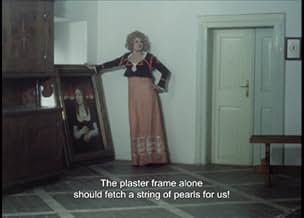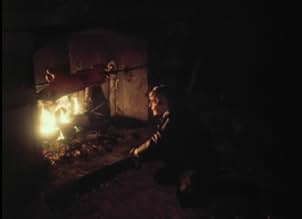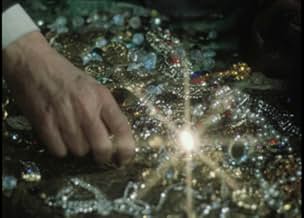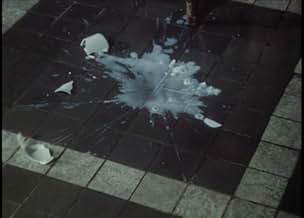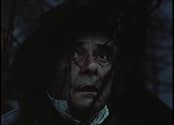NOTE IMDb
7,5/10
2,1 k
MA NOTE
Ajouter une intrigue dans votre langueIn this gothic rendition of the classic fairy tale, a merchant's youngest daughter is held prisoner by a mysterious winged beast.In this gothic rendition of the classic fairy tale, a merchant's youngest daughter is held prisoner by a mysterious winged beast.In this gothic rendition of the classic fairy tale, a merchant's youngest daughter is held prisoner by a mysterious winged beast.
- Réalisation
- Scénario
- Casting principal
- Récompenses
- 2 victoires et 1 nomination au total
Jorga Kotrbová
- Málinka
- (voix)
Tatjana Medvecká
- Julie
- (voix)
Avis à la une
What a wonderful film it is. Never having seen it before and only the Cocteau, made in 1946, a couple of times. I know there are many other versions but I think these two will be good enough for me when I like to watch this story again. I didn't really think that this one would be very good but it is amazing. Right from the beginning there is a stunning opening with a forest and a terrible ride with many horses and wagons, in the rain and the mud. Then there are the credits, even more wonderful as surrealist like paintings almost animated, unusual and original. Then back to the forest, the peasants have taken the wrong turning and they are lost but there is fire and horror. In the village and the man and his three girls with two of them getting married but he gets word that the wagons and their treasures and spices are lost and he will not make his money. There will be no wedding. He goes into the forest with his painting of his dead wife all seems to be okay and later with the third daughter she has to go into that gothic ruin in the forest and maybe find a husband. We know the story well enough but with this one and the beast or monster or her lover it is really well done and thrilling and beautiful to watch it all the time throughout. Breathtaking.
9mar9
SBS-TV used to screen this film on an annual basis, but it has been missing in action for some years, which is cause for regret. The title may seem obscure, but a look at the alternative English translations ("Maiden and the Beast" and "Virgin and the Monster") should make this clearer. This is quite simply a wonderful interpretation of the classic fairy tale of Beauty and the Beast, produced and filmed in the then Czechoslovakia. Cinematic gems can be found in what may be thought to be unlikely places, and this film is an example.
Students of cinema may be aware that Cocteau did a version of this story in B&W, and there is of course the more recent and rather tame Disney version. This film is a very different proposition. For a start, it is unsuitable for young children because of some fairly graphic violence, including scenes of animal cruelty. The film-makers seem to strive for realism, particularly the scenes in the village where Beauty (here called Julie) lives, all mud and images of earthy rural life before the Industrial Revolution. But even the magical bits are portrayed realistically. The Beast's castle is maintained by an array of goblin-like servants, who skulk in the shadows of the fireplaces and chandeliers. If I have one complaint about this film, it is that the scenes are sometimes so dark that it is difficult to see what's happening. This does heighten tension, but it can be overdone.
The actors are great, especially the two charismatic leads. The Beast (Vlastimil Harapes) is fashioned more as a great bird of prey than Cocteau's leonine creation, and there is great suspense as he struggles with his inner violent nature (a sinister whispering voice) that is urging him to remain in his beastly form and kill the innocent Julie. Julie (Zdena Studenková) in turn is wonderfully portrayed. We can see why she is so obviously her father's favourite.
Fairy tales are expositions of the human condition, and the Beauty and the Beast story is no different. "Every woman has the power the make the one she loves beautiful". It's a simple theme, but this film explores it beautifully. See it if you can.
Students of cinema may be aware that Cocteau did a version of this story in B&W, and there is of course the more recent and rather tame Disney version. This film is a very different proposition. For a start, it is unsuitable for young children because of some fairly graphic violence, including scenes of animal cruelty. The film-makers seem to strive for realism, particularly the scenes in the village where Beauty (here called Julie) lives, all mud and images of earthy rural life before the Industrial Revolution. But even the magical bits are portrayed realistically. The Beast's castle is maintained by an array of goblin-like servants, who skulk in the shadows of the fireplaces and chandeliers. If I have one complaint about this film, it is that the scenes are sometimes so dark that it is difficult to see what's happening. This does heighten tension, but it can be overdone.
The actors are great, especially the two charismatic leads. The Beast (Vlastimil Harapes) is fashioned more as a great bird of prey than Cocteau's leonine creation, and there is great suspense as he struggles with his inner violent nature (a sinister whispering voice) that is urging him to remain in his beastly form and kill the innocent Julie. Julie (Zdena Studenková) in turn is wonderfully portrayed. We can see why she is so obviously her father's favourite.
Fairy tales are expositions of the human condition, and the Beauty and the Beast story is no different. "Every woman has the power the make the one she loves beautiful". It's a simple theme, but this film explores it beautifully. See it if you can.
We've all heard or seen the classic fairy tale of "Beauty and the Beast" but it's probably fair to say that you've never seen a version as beautifully done as this 1978's Czech adaptation. Absurd you say? Like most people who grew up in the 90's, I was long under the impression that the only film version of "Beauty and the Beast" that counted was Disney's 1991 animated classic. But then I came across this version. Directed by Juraj Herz, it sets the tale in a gloomy world where we met a well to do merchant who's expecting a large shipment of priceless jewels, diamonds, the whole works. But unfortunately for him, they are stolen in route by the dreadful beast that haunts the black forest. Desperate to provide for his three daughters, he sets out to the beast's decrypted mansion to sell a priceless painting of his late wife. At first, everything goes well until he makes the mistake of plucking a rose from the beast's garden. Through some creative camera work, we don't see the beast right away but from the father's reaction know that he is hideous and angry . The beast tells him that if he wants to live, one of his daughters must come on her own free will to be with him forever. Julie, his kindest and most caring daughter, volunteers to sacrifice herself for her father despite not knowing the grisly details. When she first meets the beast, she only knows his voice since he only talks to her from behind. Yet, Julie can't help but feel something tug at her heart and what follows is one of the most dark and surreal love stories ever put to screen.
Let me just state that this is probably not the best version to show little kids due to the fact that it may give them nightmares! The director here was clearly going for a creepy and atmospheric take on the legend with the dark lighting, eerie shooting locations, and winding camera angles from the beast's point of view. In other words, it's what a fairy tale is supposed to be before Hollywood waters it down for kids. Also the music score, with its foreboding organ chimes, goes a long way to establishing suspense and apprehension as well as beauty when that organ switches to piano. As for the beast himself, he manages to be both strange and ugly with his bird/beast hybrid look (Considering the time and country it was made in, the costume and make up is fairly realistic). Since this beast is capable of using magic, he has his own goblin servants, including one who sits in chandelier that moves up and down when it's time to serve drinks. But the movie is more than just a horror picture; it's also a love story, one that is told well by its writing and actors. The filmmakers are able to present the beast as a complicated being who is torn between his new found love for Julie and his inner animal, which is presented in the form of a malicious whisper. Despite being under a lot of make up, Vlastimil Harapes is able to shine through and make you care about his plight. As for Julie, she could not be any more lovelier than in the form of Zdena Studenkova, who cuts a fine figure but more importantly, a beautiful personality for her character. Unlike her materialistic sisters, she has an innocent heart and truly cares for her father's well being, not just his money. But can Julie overcome the beast's hideous face and can the beast repress his animal instinct once and for all so they can live happily ever after? It all leads up to heartfelt conclusion that teaches us it's not what's outside that counts, but what is inside. Sadly (Maybe because it was made behind the iron curtain) the movie does not seem to be all that available. The only place I can recommend would be you tube. As far as finding a DVD, it appears to only be available in Europe. But the you tube version does have English subtitles and is in fair viewing condition. With that said, I urge you to check it out this beautifully dark version of the tale while you still can and remember that a woman makes a man she loves beautiful.
Let me just state that this is probably not the best version to show little kids due to the fact that it may give them nightmares! The director here was clearly going for a creepy and atmospheric take on the legend with the dark lighting, eerie shooting locations, and winding camera angles from the beast's point of view. In other words, it's what a fairy tale is supposed to be before Hollywood waters it down for kids. Also the music score, with its foreboding organ chimes, goes a long way to establishing suspense and apprehension as well as beauty when that organ switches to piano. As for the beast himself, he manages to be both strange and ugly with his bird/beast hybrid look (Considering the time and country it was made in, the costume and make up is fairly realistic). Since this beast is capable of using magic, he has his own goblin servants, including one who sits in chandelier that moves up and down when it's time to serve drinks. But the movie is more than just a horror picture; it's also a love story, one that is told well by its writing and actors. The filmmakers are able to present the beast as a complicated being who is torn between his new found love for Julie and his inner animal, which is presented in the form of a malicious whisper. Despite being under a lot of make up, Vlastimil Harapes is able to shine through and make you care about his plight. As for Julie, she could not be any more lovelier than in the form of Zdena Studenkova, who cuts a fine figure but more importantly, a beautiful personality for her character. Unlike her materialistic sisters, she has an innocent heart and truly cares for her father's well being, not just his money. But can Julie overcome the beast's hideous face and can the beast repress his animal instinct once and for all so they can live happily ever after? It all leads up to heartfelt conclusion that teaches us it's not what's outside that counts, but what is inside. Sadly (Maybe because it was made behind the iron curtain) the movie does not seem to be all that available. The only place I can recommend would be you tube. As far as finding a DVD, it appears to only be available in Europe. But the you tube version does have English subtitles and is in fair viewing condition. With that said, I urge you to check it out this beautifully dark version of the tale while you still can and remember that a woman makes a man she loves beautiful.
I saw this film many years ago at Filmex in Los Angeles, and it left a strong impression. It is a truly beautiful version of the fairy tale Beauty and the Beast. It is a real shame that Herz's films are not available today, at least to US cinephiles.
I remember this film as having been done in a very naturalistic way, with (I think) no optical effects at all. The costumes were wonderful, as was the music and the acting. It seems to me there was a situation in which a woman's dress turned to mud (in a simple jump cut). The "Beast" is especially striking, with his bird-like plumage.
Anyone at Facets want to take this one on?
I remember this film as having been done in a very naturalistic way, with (I think) no optical effects at all. The costumes were wonderful, as was the music and the acting. It seems to me there was a situation in which a woman's dress turned to mud (in a simple jump cut). The "Beast" is especially striking, with his bird-like plumage.
Anyone at Facets want to take this one on?
10Atulur
Although I doubt that this film was ever on in the U.S., since I live in the country where it was shot, I can warmly recommend it to anyone who loves fairy tales taken in a harsher and darker manner. The atmosphere of the film is gloomy and the camera is very original - we can see the Beast /who has here gruesome bird-like looks/ only in the middle of the film. In the first part of the film we feel his presence only through his eyes. The beginning of the movie has nothing to do with a fairy tale, it is a pure horror - a dark forest, amazing church-pipe tones, chilling to the bone, mist all around and a sudden sound of hoofs getting nearer and nearer... The dark atmosphere of the whole film is weakend by a dream interlude in which the Monster is shown as a normal human being dancing with the heroine in rooms full of glare and light. Fantastic music again. Perfect acting /best Czech actors whatsover, great choreography/,a super setting /a dark palace of the Monster/. The film will give you a totally different approach to the old well known fairy tale.
Le saviez-vous
- AnecdotesThe beast looks like a bird in this version.
- GaffesWhen the father is travelling with the painting, a crow flies out from behind a log. A crew member's hands can be seen throwing the bird upward.
- ConnexionsFeatured in Predcasná úmrtí: Bozský skeptik (2001)
Meilleurs choix
Connectez-vous pour évaluer et suivre la liste de favoris afin de recevoir des recommandations personnalisées
- How long is Beauty and the Beast?Alimenté par Alexa
Détails
Contribuer à cette page
Suggérer une modification ou ajouter du contenu manquant

Lacune principale
By what name was La Belle et la Bête (1978) officially released in India in English?
Répondre
